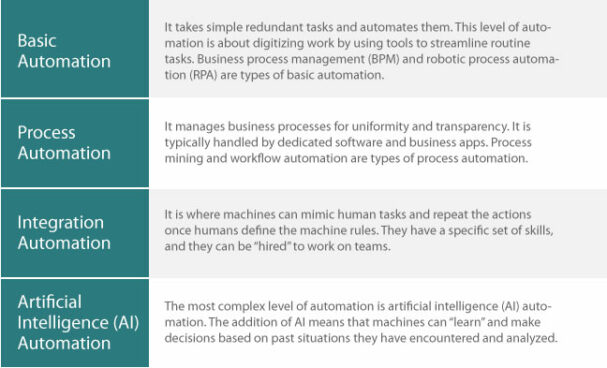
Benefits of automating your Medical Billing Process
Human race is constantly evolving, we are making our way into a better, digitally advanced future. The use of artificial intelligence is changing the way businesses operate. Business that are not adjusting to this change would struggle to survive.
Although healthcare industry was relatively slow to match the fast-growing pace of technology, it soon realized the countless advantages of automating the RCM process and jumped the wagon in time to benefit from the change.
Healthcare and Automation
MedPage today says that “for every hour of direct patient care activity, two hours are spent on typing, data entry and paperwork”.
More so, Medical Practices report a declining trend in profit margins, owing to repetitive, redundant administrative tasks that are to be taken care of as per CMS requirements. To compensate, CMS compels such practices to find means to either automate such administrative tasks or control the resources spent on them.
A study by McKinsey states that “AI can help remove or minimize time spent on routine, administrative tasks, which can take up to 70 percent of a healthcare partitions’ time”
The word automation was vastly mis-used and hence was feared for the complexities it portrayed whereas, simply put, automation is more work done with minimum to no human effort. A simple example can be, alerts on upcoming patient appointments or warning of known patient allergies by accessing the database.
In this article we discuss what automation means for the healthcare industry and what are the benefits.
What do we cover in this article?
- What is Automation?
- What does automation in healthcare industry mean?
- What are the benefits of automation for a Medical Practice?
- What steps can be automated in a Practice Management and Medical Billing/Revenue Cycle Management process for maximum optimization?
- Why is automation feared by the Medical Practice’s staff?
- How to make best of this information?
What is Automation?
Automation means using technology applications to minimize human effort and maximize results. This may include business process automation, IT automation, Artificial intelligence automation. Following are the types of automation:

What does automation in healthcare industry mean?
Automation in healthcare is highly complex. Healthcare administrators and executives must be educated in how automation interfaces with the industry to make the best use of technology and understand the challenges that it entails.
It’s important to know the difference between true automation and a mere marketing ploy. Vendors often claim to offer products or services with some automation, but this isn’t always the case. For example, a product that requires a staff member to initiate a sequence before it can work isn’t true automation.
Operations of this type include:

Adding a patient to a list

Checking them in and out

Requiring patients to use a new portal or site
Another good test of true automation is a solution that works in the background rather than requiring constant attention. A solution that would still work even if the staff didn’t know it was on is clearly automatic. Additionally, solutions that can perform a task or at least complete a sequence are probably automatic.
When Is the Time to Automate?
Healthcare organizations typically perform many tasks that benefit from automation, making it challenging to prioritize which tasks to automate first. A process that rarely happens because it’s so time-consuming is often a strong candidate for automation.

You may also want to consider automating a process in which the effort required to complete it is greater than the benefit it provides. This is a routine calculation in healthcare due to the time-sensitive nature of many procedures in this industry. Professionals often make a conscious decision to avoid tasks that don’t provide a benefit greater than the time needed to perform them. For example, many organizations don’t standardize appointment types due to the difficulty involved in quantifying the benefits this process provides.
If they are to be successful in the 21st century, healthcare leaders must be prepared to take advantage of automation trends.
What are the benefits of automation for a Medical Practice?
Healthcare leaders already know that automation works.

* As per healthcare industry organization CAQH
Implementing automation in healthcare will likely be the first responsibility of new healthcare administrators as they are tasked with lowering costs, improving care quality, and using data analysis to support decision-making.
This article discusses eight of the most important benefits of automation in healthcare.
Benefits of Automation
Automation is re-imagining healthcare by enabling efficiencies that would be impossible with manual processes. As a result of freeing staff from less human-facing work, patients receive better care. The following list describes some specific benefits of automation in healthcare.
1. Simple Scheduling
Scheduling appointments manually has proven difficult due to the significant possibility of scheduling conflicts and the various rules that need to be considered in order to match the right patient with the right provider and location. Appointment scheduling software is highly effective at automating this task, allowing healthcare organizations to schedule and cancel appointments much more efficiently.
There are, however, important considerations to ensure the software will effectively and efficiently manage your practices and patients’ needs. This includes integrating with your EHR/PM platform to identify the rules around scheduling so schedulers and patients can easily make appointments.
2. Reducing Cost
Cost reduction is the primary reason most healthcare executives implement automation solutions. They accomplish this goal in several ways, including less overtime, improved efficiency, and fewer errors. Automation allows practitioners to accomplish more within their normal shifts, reducing their overall stress. This improvement in efficiency means that healthcare facilities don’t need staff to work as much overtime. It also allows staff to focus on patient care, resulting in fewer payouts due to medical errors.
Best-in-class scheduling software can also reduce training or onboarding costs because schedulers are able to automate rules that previously could only be managed with binders, sticky notes, and Excel spreadsheets, especially in specialty groups. Additionally, providing an easy-to-use online scheduling option for patients on your website is one way to reduce patient acquisition costs.
3. Easy Transfer and Access to Data
Many facilities are automating the transfer and access of patient data. These types of automated solutions instantly add patient data to a database once it’s collected, allowing facilities to easily share that data between departments and other facilities. This benefit of automation is particularly useful as data sharing is currently a major challenge in the healthcare industry.
Data transfers can lead to bottlenecks in the treatment workflow when a patient’s diagnosis or treatment involves multiple departments. Automation allows every device in a facility to be connected to the same network, making information from one device accessible from another device. This capability saves time by reducing administrative overhead.
Of course, Info-security and cybersecurity are critical with any information, especially PII and patient data. So, you’ll want to ensure your technology partners and solutions have proper security certifications in order to stay compliant with HIPAA and TCPA security standards.
4. Fewer Errors
Automation helps to reduce the risk of error in a process by minimizing the human element, resulting in more effective treatment. Provider tools to diagnose and treat patients can lend themselves to automation, but automating processes can also improve administrative operations.
Sharing data between multiple systems increases this probability by providing greater insight into these processes. For example, administrators can use data from various sources to reduce lead times for surgery or other appointments. Healthcare facilities can also use the increased reliability of automation to offer their services to a larger population or help a patient find an alternative location to receive care sooner.
5. Handling Emergencies and Adapting to Change
Healthcare systems are starting to use machine learning (ML) to adjust staffing levels in response to sudden changes in patient volume, especially in emergency rooms. This feature of automation can also reduce wait times for ambulatory services. For example, organizations can better predict the times they need to increase staff for an upcoming flu season by analyzing historical data from multiple sources.
Most recently, practices use automation to respond more quickly to changes resulting from the Covid-19 pandemic, including adjustments in social distancing and maximum occupation capacities for buildings. Messaging solutions that allow patients and staff to communicate are another example of the ways automation can help healthcare facilities cope with changes in local guidelines and even handle emergencies or office closures more effectively.
6. Higher Patient Satisfaction
Several factors impact patient satisfaction in a healthcare system, including the level of care the patient receives at a facility. The ease of scheduling, checking in, and completing appointments are also critical when it comes to keeping patients happy. Another major factor in patient satisfaction is the total time required for the appointment, including how long it takes to get an appointment and wait time on the day of.
Automating healthcare processes allows organizations to improve patient satisfaction and the patient experience in a variety of ways. For example, they can implement software that sends patients a text message to reschedule appointments if they can no longer make it or miss it.
Advanced scheduling software also allows patients to schedule their own appointments on a mobile device or computer anytime, even after office hours. This type of self-scheduling software shows patients all the available time slots for appointments, giving them the freedom to select the one most convenient for them based on the provider they need to see and the type of appointment needed.
7. Better Privacy
As mentioned previously, healthcare organizations must ensure they follow Health Insurance Portability and Accountability Act (HIPAA) regulations to protect the Protected Health Information (PHI) and Personally Identifiable Information (PII) of patients. Solutions that automate case management data help ensure HIPAA compliance by configuring usage rights. This function ensures that only authorized personnel are able to access PHI.
8. Scheduling Patients More Quickly
Automated scheduling solutions help patients schedule their appointments online, which is much easier and faster than the traditional method of calling the practice directly. These solutions provide self-scheduling 24/7 from any device with internet access and a web browser, allowing patients to quickly schedule their own appointment.
These automated online scheduling solutions also allow patients to specify other details of the appointment such as its purpose, type, and the length of time required. In addition, patients can apply customizable filters to help patients find the right providers. Practices are able to leverage the same rules and automated workflows they’d use when having a scheduler book an appointment on the phone when patients schedule themselves, which allows them to maintain controls and ensure the right provider and appointment type is booked.
What steps can be automated in the Practice Management and Revenue Cycle Management / Medical Billing Processes?
- Scheduling
- Insurance Verification
- Claim Creation and Validation
- Claim Submission
- Claim Tracking
- Denial management
- Payment Posting
- Patient AR Management
- Analytics and Reporting
Contact us for more details on automating the above steps.

Why is automation feared by the Medical Practice’s staff?
The prospect of automating processes often raises concerns about reducing staff. However, a truly automated solution allows workers to focus on clinically relevant tasks rather than administrative tasks that often fall outside their area of expertise. As a result, automation doesn’t mean laying off workers in an industry as chronically understaffed as healthcare. In fact, studies consistently show that fully automated solutions improve staff satisfaction.
Staff training should be an integral part of the deployment of an automated solution. In addition to teaching the new technology, this training should also explain how it will make the lives of staff members and patients easier. These steps all help staff members adapt to their new schedules as quickly as possible.
How to make best of this information in healthcare?
Automation is becoming more common in healthcare, although the distinction between true automation and a vendor’s claim remains important. Many tasks in healthcare lend themselves to automation, making it essential to prioritize those that will obtain the most significant benefits from automation. These benefits include lower costs, greater patient satisfaction, and empowering staff to be more efficient.
Analyze your Medical Billing process to pin point repetitive, redundant steps and then seek for automated solutions.
AltuMED pushes its client Medical Practices and Labs to conduct systematic Medical Billing Performance Audits. A Medical Billing Performance Audit is often viewed as a defensive measure where as it should be practiced regularly. Think of it this way, what would you rather prefer? A visit to preventive care or to an emergency room? Why not start your Medical Billing Performance Diagnostic instantly, Click the button below
Subscribe to Our Newsletter!
Subscribe to Our Newsletter!
Enter Your Email Address. We Promise We Won't Spam You
Relevant Articles
Categories
Informational
Educational
Medical Billing Software
Follow Us
